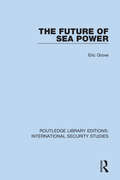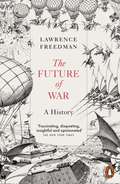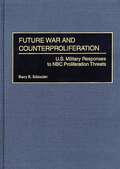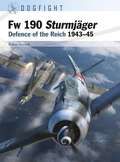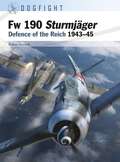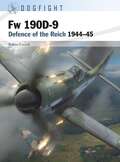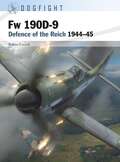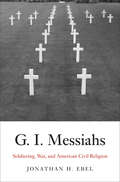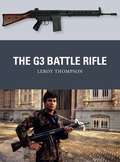- Table View
- List View
The Future of Non-lethal Weapons: Technologies, Operations, Ethics and Law
by Nick LewerThese essays explore the increase in interest in non-lethal weapons. Such devices have meant that many armed forces and law enforcement agencies are able to act against undesirables without being accused of acting in an inhumane way. Topics for discussion in this volume include: an overview of the future of non-lethal weapons; emerging non-lethal technologies; military and police operational deployment of non-lethal weapons; a scientific evaluation of the effectiveness of non-lethal weapons; changes in international law needed to take into account non-lethal technologies; developments in genomics leading to new chemical incapacitants; implications for arms control and proliferation; the role of non-lethal weapons in human rights abuses; conceptual, theoretical and analytical perspectives on the nature of non-lethal weapons development.
The Future of Sea Power (Routledge Library Editions: International Security Studies #9)
by Eric GroveThis book, first published in 1990, presents a fundamental reassessment of maritime strategy. It analyses the lessons of twentieth-century naval warfare and examines in detail the changing face of naval warfare, both in terms of the weapons used and the platforms from which they are launched and controlled. It looks at the evolving uses of the seas, both economic and military, and sets sea power against the developing world environment, political, legal and economic, discussing those factors that stimulate nations to exert power at sea and those that limit their naval capabilities. It also develops a theoretical framework for future thinking about maritime strategy and forces, revises and updates Mahan’s classical analysis of the foundations of sea power, and discusses thinking about naval tasks.
The Future of Sea Power (Routledge Library Editions: International Security Studies #9)
by Eric GroveThis book, first published in 1990, presents a fundamental reassessment of maritime strategy. It analyses the lessons of twentieth-century naval warfare and examines in detail the changing face of naval warfare, both in terms of the weapons used and the platforms from which they are launched and controlled. It looks at the evolving uses of the seas, both economic and military, and sets sea power against the developing world environment, political, legal and economic, discussing those factors that stimulate nations to exert power at sea and those that limit their naval capabilities. It also develops a theoretical framework for future thinking about maritime strategy and forces, revises and updates Mahan’s classical analysis of the foundations of sea power, and discusses thinking about naval tasks.
The Future of Terrorism (Political Violence)
by Max Taylor John HorganThese papers from a meeting on terrorism in Cork in 1999 include: the effects of changing geo-politics on terrorism; strategic and tactical responses to innovations in terrorism; the changing nature of terrorism; the threat of weapons of mass destruction; and single-issue terrorism.
The Future of Terrorism (Political Violence #Vol. 9)
by Max. Taylor John HorganThese papers from a meeting on terrorism in Cork in 1999 include: the effects of changing geo-politics on terrorism; strategic and tactical responses to innovations in terrorism; the changing nature of terrorism; the threat of weapons of mass destruction; and single-issue terrorism.
The future of U.S.–India security cooperation
by Sumit Ganguly M. Chris MasonThis book deals with the evolution, current status and potential of U.S.-India strategic cooperation. From very modest beginnings, the U.S.-India strategic partnership has developed significantly over the last decade. In considerable part, this growth has stemmed from overlapping concerns about the rise and assertiveness of the People’s Republic of China, as well as the instability of Pakistan. Despite the emergence of this partnership, significant differences remain, some of which stem from Cold War legacies, others from divergent global strategic interests and institutional design. In spite of these areas of discord, the overall trajectory of the relationship appears promising. Increased cooperation and closer policy coordination underscore a deepening of the relationship, while fundamental differences in national approaches to strategic challenges demand flexibility and compromise in the future.
The future of U.S.–India security cooperation
by Šumit Ganguly and M. Chris MasonThis book deals with the evolution, current status and potential of U.S.-India strategic cooperation. From very modest beginnings, the U.S.-India strategic partnership has developed significantly over the last decade. In considerable part, this growth has stemmed from overlapping concerns about the rise and assertiveness of the People’s Republic of China, as well as the instability of Pakistan. Despite the emergence of this partnership, significant differences remain, some of which stem from Cold War legacies, others from divergent global strategic interests and institutional design. In spite of these areas of discord, the overall trajectory of the relationship appears promising. Increased cooperation and closer policy coordination underscore a deepening of the relationship, while fundamental differences in national approaches to strategic challenges demand flexibility and compromise in the future.
The Future of US Warfare (Military Strategy and Operational Art)
by Scott N. Romaniuk Francis GriceThis book provides an interdisciplinary analysis of the future of US warfare, including its military practices and the domestic and global challenges it faces. The need to undertake a comprehensive analysis about the future of warfare for the US is more pressing today than ever before. New technologies and adversaries, both old and new, have the potential to revolutionize how wars are fought, and it is imperative that policy makers, military planners, and scholars engage with the latest analyses regarding these new threats and weapon systems. The primary aim of this book is to provide a clear and comprehensive depiction of the types of conflict that the United States is likely to become involved with in the future, as well as the methods of warfare that it may employ within these struggles. While a number of scholarly books have previously considered some of the potential features of US warfare in the future, many of these writings are either outdated or have limited their focus to just one or two of the main types of warfare that may occur and omitted consideration of the others. This book intends to remedy this deficiency in the literature. The volume consists of thematic chapters which address the key issues relevant to the future of US warfare, including cyber warfare, asymmetric conflicts, drone warfare, and nuclear strategy. Through the provision of a series of analyses by leading international academics, the volume provides an important interdisciplinary examination of the different areas of warfare that the United States is expected to use or encounter in the future. This book will be of great interest to students of US foreign policy, military studies, strategic studies and International Relations in general.
The Future of US Warfare (Military Strategy and Operational Art)
by Scott N. Romaniuk Francis GriceThis book provides an interdisciplinary analysis of the future of US warfare, including its military practices and the domestic and global challenges it faces. The need to undertake a comprehensive analysis about the future of warfare for the US is more pressing today than ever before. New technologies and adversaries, both old and new, have the potential to revolutionize how wars are fought, and it is imperative that policy makers, military planners, and scholars engage with the latest analyses regarding these new threats and weapon systems. The primary aim of this book is to provide a clear and comprehensive depiction of the types of conflict that the United States is likely to become involved with in the future, as well as the methods of warfare that it may employ within these struggles. While a number of scholarly books have previously considered some of the potential features of US warfare in the future, many of these writings are either outdated or have limited their focus to just one or two of the main types of warfare that may occur and omitted consideration of the others. This book intends to remedy this deficiency in the literature. The volume consists of thematic chapters which address the key issues relevant to the future of US warfare, including cyber warfare, asymmetric conflicts, drone warfare, and nuclear strategy. Through the provision of a series of analyses by leading international academics, the volume provides an important interdisciplinary examination of the different areas of warfare that the United States is expected to use or encounter in the future. This book will be of great interest to students of US foreign policy, military studies, strategic studies and International Relations in general.
The Future of War: The Re-Enchantment of War in the Twenty-First Century (Wiley-Blackwell Manifestos)
by Christopher CokerIn this book, Professor Christopher Coker presents an original and controversial thesis about the future of war. Argues that the biotechnology revolution has given war a new lease of life. Draws on thinkers from Hegel and Nietzsche to the postmodernists. Refers to modern fiction and films. Part of the prestigious Blackwell Manifestos series.
The Future of War: A History
by Sir Lawrence FreedmanA new approach to ideas about war, from one of the UK's leading strategic thinkersIn 1912 Sir Arthur Conan Doyle wrote a short story about a war fought from underwater submersibles that included the sinking of passenger ships. It was dismissed by the British admirals of the day, not on the basis of technical feasibility, but because sinking civilian ships was not something that any civilised nation would do. The reality of war often contradicts expectations, less because of some fantastic technical or engineering dimension, but more because of some human, political, or moral threshold that we had never imagined would be crossed. As Lawrence Freedman shows, ideas about the causes of war and strategies for its conduct have rich and varied histories which shape predictions about the future. Freedman shows how looking at how the future of war was conceived about in the past (and why this was more often than not wrong) can put into perspective current thinking about future conflicts. The Future of War - which takes us from preparations for the world wars, through the nuclear age and the civil wars which became the focus for debate after the end of the Cold War, to present preoccupations with hybrid and cyber warfare - is filled with fascinating insights from one of the most brilliant military and strategic historians of his generation.
Future War and Counterproliferation: U.S. Military Responses to NBC Proliferation Threats (Praeger Security International Ser.)
by Barry R. SchneiderThe United States faces a small number of rogue states that either have or are working to acquire weapons of mass destruction. These NASTIs, or NBC-Arming Sponsors of Terrorism and Intervention, include such states as North Korea, Iraq, Iran, Libya, and Syria. U.S. nonproliferation programs and policies have helped to keep this number small, but U.S. and allied counterproliferation programs are essential to reduce the danger. It is up to deterrence, active defenses, passive defenses, decontamination, and counterforce to turn enemy weapons of mass destruction into instruments of limited destructive effect.Warfighters will also have to adopt a different strategy and concept of operations in fighting an adversary that is so heavily armed. This strategy will feature a combination of deception, dispersion, mobility and maneuver, diffused logistics, remote engagement, missile defense bubbles, non-combatant evacuation operations, and large area decontamination. It will also involve upgrades to NBC passive defense measures and equipment, as well as a counterforce capability that can find and destroy a variety of adversary targets, including mobile launchers and deeply buried and hardened underground structures.
Future War In Cities: Rethinking a Liberal Dilemma
by Alice HillsThis book is the first full-length study of a key security issue confronting the west in the twenty-first century, urban military operations - as currently being undertaken by US and UK forces in Iraq. It relates military operations in cities to the wider study of conflict and security in an era of urbanisation, expeditionary warfare and new power
Future War In Cities: Rethinking a Liberal Dilemma
by Alice HillsThis book is the first full-length study of a key security issue confronting the west in the twenty-first century, urban military operations - as currently being undertaken by US and UK forces in Iraq. It relates military operations in cities to the wider study of conflict and security in an era of urbanisation, expeditionary warfare and new power
Fw 190 Defence of the Reich Aces (Aircraft of the Aces)
by John WealRenowned aviation author and artist, John Weal, presents the last volume of Fw 190 Aces not previously covered in the Aircraft of the Aces series. From mid-1942 until the end of the war, German fighter pilots were deployed in the defence of the homeland in an effort to halt the near-constant bombing raids by Britain and America. This book tells their story, from the moment when the Luftwaffe began to retreat to the dying days of the Reich. Using previously unpublished photographs, this book charts the story of the men who earned their status as aces while fighting a hopeless battle to protect the land and the people they loved.
Fw 190 Defence of the Reich Aces (Aircraft of the Aces #92)
by John WealRenowned aviation author and artist, John Weal, presents the last volume of Fw 190 Aces not previously covered in the Aircraft of the Aces series. From mid-1942 until the end of the war, German fighter pilots were deployed in the defence of the homeland in an effort to halt the near-constant bombing raids by Britain and America. This book tells their story, from the moment when the Luftwaffe began to retreat to the dying days of the Reich. Using previously unpublished photographs, this book charts the story of the men who earned their status as aces while fighting a hopeless battle to protect the land and the people they loved.
Fw 190 Sturmjäger: Defence of the Reich 1943–45 (Dogfight #11)
by Robert ForsythAn illustrated account of how the USAAF's might was challenged by the Jagdflieger and their heavily armed, and armoured, Fw 190A-8 Sturmjäger. Developed from one of the finest fighters of World War II, the radial-engined Fw 190A-8 was conceived as a heavy assault aircraft and armed accordingly. Its mission was to provide a response to the increasing numbers of USAAF B-17 and B-24 bombers operating against targets in the western and central Reich. This book explores the fascinating feats of the men flying the Fw 190A-8 and its subvariants. These pilots were given exceptional training and many were volunteers, some of whom were willing to sign oaths that they would bring down a bomber at all costs – even if it meant ramming the enemy aircraft. Using first-hand accounts, archival photos, full-colour illustrations, maps and tactical diagrams, acclaimed Luftwaffe expert Robert Forsyth puts readers in the cockpit of a Sturmjäger defending the Fatherland from USAAF bombers protected by powerful Allied escort fighters.
Fw 190 Sturmjäger: Defence of the Reich 1943–45 (Dogfight #11)
by Robert ForsythAn illustrated account of how the USAAF's might was challenged by the Jagdflieger and their heavily armed, and armoured, Fw 190A-8 Sturmjäger. Developed from one of the finest fighters of World War II, the radial-engined Fw 190A-8 was conceived as a heavy assault aircraft and armed accordingly. Its mission was to provide a response to the increasing numbers of USAAF B-17 and B-24 bombers operating against targets in the western and central Reich. This book explores the fascinating feats of the men flying the Fw 190A-8 and its subvariants. These pilots were given exceptional training and many were volunteers, some of whom were willing to sign oaths that they would bring down a bomber at all costs – even if it meant ramming the enemy aircraft. Using first-hand accounts, archival photos, full-colour illustrations, maps and tactical diagrams, acclaimed Luftwaffe expert Robert Forsyth puts readers in the cockpit of a Sturmjäger defending the Fatherland from USAAF bombers protected by powerful Allied escort fighters.
Fw 190D-9: Defence of the Reich 1944–45 (Dogfight)
by Robert ForsythThe Fw 190D-9 – the 'long-nosed' Dora – represented the cutting edge and pinnacle of wartime Germany's piston-engine aviation development. This new history by leading German aviation specialist Robert Forsyth reveals what it was like to pilot her in combat as Germany desperately battled to remain in the war.Arguably one of the finest piston-engined fighters ever built, the Focke-Wulf Fw 190D-9 raised the bar in terms of aircraft design and operational capability during World War II. Designed by Kurt Tank, the 'long-nosed' Fw 190D9 'Dora' bettered most of the fighters that the Allied and Soviet air forces could field when it first appeared in the skies over the Western and Eastern Fronts in 1944. Indeed, with experienced German pilots at the controls it proved to be an immediate match for even the later-mark Griffon Spitfire and the P-51D/K. Well-armed, with two 13mm machine guns and two 20mm cannon, the D-9 began to equip Luftwaffe units from August 1944. Later on in the war, one of the key missions of the D-9 was to provide top cover for Me 262 jet fighters when they were at their most vulnerable during take-off and landing. Featuring first-hand accounts, photographs, artwork and innovative and colourful 3D ribbon diagrams, this fascinating volume portrays what it was like to fly the superlative Fw 190D-9 in combat, providing a realistic insight in to how German pilots used the superb Focke-Wulf aircraft in combat against American, British and Russian fighters in the Defence of the Reich in 1944–45.
Fw 190D-9: Defence of the Reich 1944–45 (Dogfight #97)
by Robert ForsythThe Fw 190D-9 – the 'long-nosed' Dora – represented the cutting edge and pinnacle of wartime Germany's piston-engine aviation development. This new history by leading German aviation specialist Robert Forsyth reveals what it was like to pilot her in combat as Germany desperately battled to remain in the war.Arguably one of the finest piston-engined fighters ever built, the Focke-Wulf Fw 190D-9 raised the bar in terms of aircraft design and operational capability during World War II. Designed by Kurt Tank, the 'long-nosed' Fw 190D9 'Dora' bettered most of the fighters that the Allied and Soviet air forces could field when it first appeared in the skies over the Western and Eastern Fronts in 1944. Indeed, with experienced German pilots at the controls it proved to be an immediate match for even the later-mark Griffon Spitfire and the P-51D/K. Well-armed, with two 13mm machine guns and two 20mm cannon, the D-9 began to equip Luftwaffe units from August 1944. Later on in the war, one of the key missions of the D-9 was to provide top cover for Me 262 jet fighters when they were at their most vulnerable during take-off and landing. Featuring first-hand accounts, photographs, artwork and innovative and colourful 3D ribbon diagrams, this fascinating volume portrays what it was like to fly the superlative Fw 190D-9 in combat, providing a realistic insight in to how German pilots used the superb Focke-Wulf aircraft in combat against American, British and Russian fighters in the Defence of the Reich in 1944–45.
Fw 200 Condor Units of World War 2 (Combat Aircraft)
by Chris Davey Mark Postlethwaite Chris GossThe Fw 200 Condor first made an appearance over Norway in April 1940, flying with the unit that eventually become synonymous with it – Kampfgeschwader 40. As the war in the west progressed, and German forces advanced, French airfields opened up, allowing the Condor to fly around the UK and out into the Atlantic, where it rapidly established itself as one of the key menaces to Allied shipping. Able to attack shipping directly, or able to guide U-Boats to their prey the Condor scored its first major success when it crippled the liner Empress of Great Britain.But the tables were to turn on the 'Scourge of the Atlantic' as mechanical failures induced by their harsh operating environment and changes in Allied tactics began to take a toll. Vulnerable to aerial attack, the deployment of Allied carriers and their associated fighters combined with the introduction of more loing range maritime patrol aircraft exposed the Condor's deficiencies. Packed with rare first-hand accounts, profile artwork and photographs, this is the history of one of the unsung types to take to the skies during World War 2.
Fw 200 Condor Units of World War 2 (Combat Aircraft #115)
by Mr Chris Davey Mr Mark Postlethwaite Mr Chris GossThe Fw 200 Condor first made an appearance over Norway in April 1940, flying with the unit that eventually become synonymous with it – Kampfgeschwader 40. As the war in the west progressed, and German forces advanced, French airfields opened up, allowing the Condor to fly around the UK and out into the Atlantic, where it rapidly established itself as one of the key menaces to Allied shipping. Able to attack shipping directly, or able to guide U-Boats to their prey the Condor scored its first major success when it crippled the liner Empress of Great Britain.But the tables were to turn on the 'Scourge of the Atlantic' as mechanical failures induced by their harsh operating environment and changes in Allied tactics began to take a toll. Vulnerable to aerial attack, the deployment of Allied carriers and their associated fighters combined with the introduction of more loing range maritime patrol aircraft exposed the Condor's deficiencies. Packed with rare first-hand accounts, profile artwork and photographs, this is the history of one of the unsung types to take to the skies during World War 2.
G.I. Joe in France: From Normandy to Berchtesgaden (Praeger Security International)
by J.E Kaufmann H.W KaufmannThis book chronicles the experience of the World War II paratroopers from their earliest days in training to final days of the war spent at Berchtesgaden. Relying heavily on memoirs, letters, and personal interviews with soldiers, this work highlights the rigors of training, the spectacle of combat, and the relief of survival and victory. From D-Day to Bastogne, Kaufmann follows the American advance across France, shedding light on the emotional strain and shock of combat that was, until recently, often overlooked by generations of Americans, but freely admitted to by the Vets themselves. Along the way, the book details the struggle faced by American G.I.s as they made their way through France. Indeed, it becomes clear the Nazis were not the only obstacle to Mutt and Joe during the campaign. The common problems of supply and relief often exacerbated difficult conditions in the field, while incompetent line officers often raised doubt and suspicion among men in the ranks. Ultimately, this is a very personal story about struggle and triumph, told by those who endured the hardship of combat.
G.I. Messiahs: Soldiering, War, and American Civil Religion
by Jonathan H. EbelJonathan Ebel has long been interested in how religion helps individuals and communities render meaningful the traumatic experiences of violence and war. In this new work, he examines cases from the Great War to the present day and argues that our notions of what it means to be an American soldier are not just strongly religious, but strongly Christian. Drawing on a vast array of sources, he further reveals the effects of soldier veneration on the men and women so often cast as heroes. Imagined as the embodiments of American ideals, described as redeemers of the nation, adored as the ones willing to suffer and die that we, the nation, may live—soldiers have often lived in subtle but significant tension with civil religious expectations of them. With chapters on prominent soldiers past and present, Ebel recovers and re-narrates the stories of the common American men and women that live and die at both the center and edges of public consciousness.
The G3 Battle Rifle (Weapon)
by Leroy ThompsonDuring the Cold War, the G3 was one of the world's pre-eminent battle rifles. Developed in France and Spain after 1945, the rifle was produced by the German arms manufacturer Heckler & Koch. Adopted by more than 40 countries and produced on licence by many more, it was widely employed during colonial wars in Africa, insurgencies in Latin America and conflicts in the Middle East, but perhaps its widest use was in the Iran–Iraq War. Variants of the G3 have also seen substantial usage among Special Forces including Britain's Special Boat Service and the US Navy SEALs. Semi-automatic versions, especially the HK91 and HK93, remain popular in the United States, and the G3-derived HK11 and HK21 family of light machine guns have also been widely adopted by military and law-enforcement units across the world. Fully illustrated with specially commissioned artwork, this study examines one of the iconic weapons of the Cold War era.

